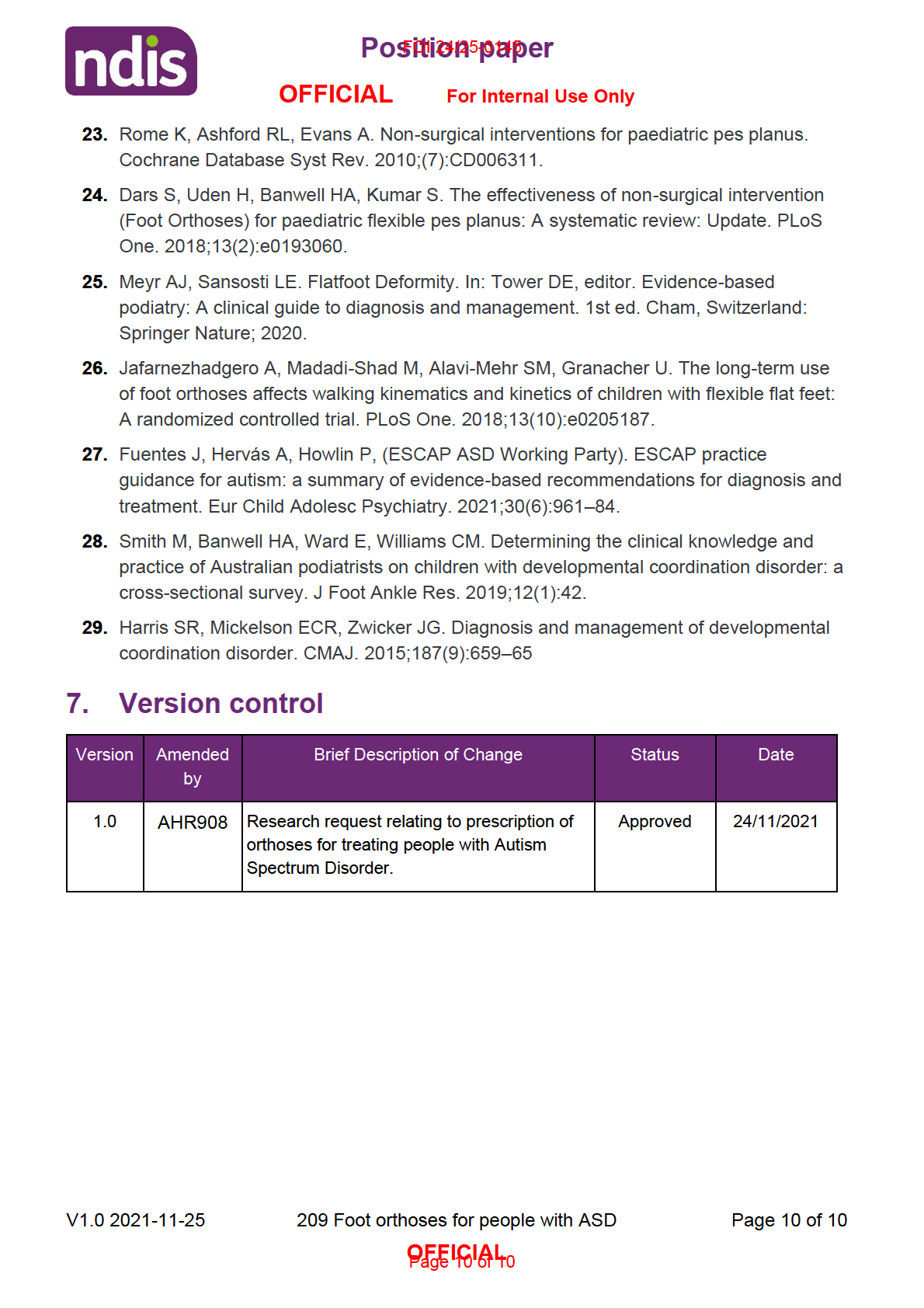 DOCUMENT 5
Positi
DOCUMENT 5
Positi
FOI
on pape
24/25-0145
r
OFFICIAL
For Internal Use Only
Foot Orthoses for people with Autism Spectrum
Disorder
The content of this document is OFFICIAL.
Please note:
The research and literature reviews collated by our TAB Research Team are not to be
shared external to the Branch. These are for internal TAB use only and are intended to
assist our advisors with their reasonable and necessary decision-making.
Delegates have access to a wide variety of comprehensive guidance material. If
Delegates require further information on access or planning matters they are to call the
TAPS line for advice.
The Research Team are unable to ensure that the information listed below provides an
accurate & up-to-date snapshot of these matters.
Research question: Do foot orthoses provide a benefit to ambulation for people with Autism
Spectrum Disorder?
Date: 25/11/2021
Requestor: Nawaal s47F - personal p
Endorsed by: Melinda s47F - personal privacy
Cleared by: Melinda s47F - personal privacy
V1.0 2021-11-25
209 Foot orthoses for people with ASD
Page 1 of 10
OFFICIAL
Page 1 of 10
 Positi
Positi
FOI
on pape
24/25-0145
r
OFFICIAL
For Internal Use Only
1. Contents
Foot Orthoses for people with Autism Spectrum Disorder ......................................................... 1
1.
Contents ....................................................................................................................... 2
2.
Summary ...................................................................................................................... 2
3.
Motor difficulties for people with Autism Spectrum Disorder ......................................... 2
4.
Effectiveness of foot orthoses ....................................................................................... 4
4.1
What are foot orthoses? ............................................................................................ 4
4.2
Effectiveness of treatment ......................................................................................... 5
4.3
Foot orthoses for people with ASD ............................................................................ 6
5.
Reasonable and necessary .......................................................................................... 7
6.
References ................................................................................................................... 8
7.
Version control ............................................................................................................ 10
2. Summary
There is a lack of evidence for the effectiveness of foot orthoses for people with Autism
Spectrum Disorder (ASD). However, there is some indication that foot orthoses can assist in
treating and managing conditions associated with ASD. Foot orthoses may help reduce toe-
walking. There is very little evidence that orthoses can assist with mobility in people diagnosed
with Developmental Coordination Disorder (DCD), a condition associated with ASD. However,
there is evidence that foot orthoses assist with the management of pain and associated
function for a variety of other conditions such as flat feet, high arches, bunions, juvenile
idiopathic arthritis, rheumatoid arthritis and knee pain. Quality of studies vary.
3. Motor difficulties for people with Autism Spectrum
Disorder
ASD is a neurodevelopmental disorder characterised by difficulties in social interaction and
social communication, including restrictive, repetitive, and inflexible patterns of behaviour [1,2].
DSM 5 notes that people with ASD can often also experience motor deficits such as
clumsiness and problems with gait (1). Motor deficits are included as ‘additional features
supporting diagnosis’, though there is a growing body of evidence supporting the idea that
motor deficits are a core feature of ASD [1,3,4,5].
In a study of 11,814 participants, Bhat et al find 86.9% of children with ASD are at risk of motor
impairments. Zampella et al report that up to 76% of children with ASD meet the diagnostic
V1.0 2021-11-25
209 Foot orthoses for people with ASD
Page 2 of 10
OFFICIAL
Page 2 of 10


 Positi
Positi
FOI
on pape
24/25-0145
r
OFFICIAL
For Internal Use Only
criteria for DCD. DCD is a motor disorder characterised by motor skills substantially below
what is expected at a person’s age [5]. People with ASD are at greater risk of low muscle tone
(hypotonia) and apraxia [3,6].
Of particular interest is the prevalence of motor deficits that can affect gait. An earlier study on
the prevalence of motor deficits in children with ASD finds 19% present with toe-walking, 9%
with a gross motor delay and 2% with reduced ankle mobility [Table1,3]. A later study finds
68% of children with ASD have some form of gait abnormality [Table2,6]. Children with ASD
are at higher risk of toe-walking [3,6,7]. Estimates of the prevalence of toe walking in people
ASD range from 9% [8] to 20% [3,9,10]. A 2015 review found considerable disagreement over
the specifics of a pattern of gait in people with ASD, concluding that deviations in gait are a
common symptom of ASD [11]. This heterogeneity is echoed by Dufek et al, who observe that
the participants in their study displayed varied patterns of gait but generally showed an
increase in gait abnormalities [12].
Table 1. The prevalence of motor deficits in ASD.
Table 2. Gait abnomalities in children with Autism.
Motor deficits in children can impact social interaction and communication [5]. However, that
motor deficits are present in individuals with ASD does not indicate that they necessarily
experience the deficit as an impairment or that they require a specific kind of support. As
shown in Table 1, prevalence of motor deficits tends to reduce with age. Although this is likely
not the case for people diagnosed with DCD [29]. Dietz and Khunsree argue that evidence for
the harm of toe-walking is lacking and that beyond social stigma toe-walking may ultimately be
a benign condition [13]. On the contrary, Herrin and Geil argue that there are short and long
term harms to toe-walking including:
• decreased walking velocity due to decreased stride length and cadence
V1.0 2021-11-25
209 Foot orthoses for people with ASD
Page 3 of 10
OFFICIAL
Page 3 of 10
 Positi
Positi
FOI
on pape
24/25-0145
r
OFFICIAL
For Internal Use Only
• greater risks for falling
• greater effort than normal gait
• contracted Achilles tendon
• equinus position of the foot/ankle complex
• lumbar spine hyperlordosis
• deformities of bones and soft tissues in the feet
• abnormal adult gait [14].
Leyden, Frung and Frick note that some biomechanical and gait changes have been noted in
people toe-walking for years, though they temper this with the observation that long term
consequences of toe-walking are generally unknown [8]. Mediating this disagreement to some
extent, we can point out that some toe-walkers exhibit this behaviour more and some less, i.e.
many people who toe-walk also show standard gait at times. In one study, participants walking
barefoot displayed toe-walking behaviour in 36% of steps [15]. I have not found research to
link frequency of toe-walking behaviour with real functional impact (ie. research linking
percentage of tow-walking footfalls with substantial mobility deficits).
While it is clear from the evidence that people with ASD experience problems with gait and
motor skills at a higher rate than people without ASD, they do not receive treatment at a higher
rate and continue to be under-diagnosed with motor impairments and DCD [3].
4. Effectiveness of foot orthoses
4.1 What are foot orthoses?
An orthosis or orthotic device is an “externally applied device used to compensate for
impairments of the structure and function of the neuro-muscular and skeletal systems” [16].
Common lower limb orthoses include:
• Toe – designed to wedge in between toes
• Insoles – able to slip inside shoes, available custom made or prefabricated, can be
heel, ¾ length or full length
• Sub Malleolar – covers the whole foot but stopping below the ankle
• Supra Malleolar – covers the whole foot and ankle
• Ankle-Foot – covers all or part of the foot, the ankle and stops just below the knee,
can be articulated or solid, lined or padded and with or without a sole
• Knee – covers knee joint and stops above the ankle and below the hip, can be
custom moulded or prefabricated
V1.0 2021-11-25
209 Foot orthoses for people with ASD
Page 4 of 10
OFFICIAL
Page 4 of 10
 Positi
Positi
FOI
on pape
24/25-0145
r
OFFICIAL
For Internal Use Only
• Knee-Ankle-Foot – covers all or part of the foot, over the ankle and knee and stops
just below the hip joint, can be articulated at ankle or knee, fully or partly custom
moulded
• Hip – usually covering lower back and hip joint stopping before the knee, custom
moulded or prefabricated
• Knee-Hip-Ankle-Foot – covers all or part of the foot, over the ankle, knee and hip but
should not obstruct movement of the spine [17,18].
4.2 Effectiveness of treatment
Foot orthoses are a commonly prescribed treatment and management technique for a variety
of lower body pain and functional/mobility issues. Orthoses, prescription footwear and physical
therapy are often called ‘conservative’ treatments to contrast these with surgical interventions
[19].
A 2008 Cochrane review of 11 randomised control trials found evidence that custom made
insoles can reduce the pain associated with high arches (pes cavus), juvenile idiopathic
arthritis, rheumatoid arthritis and bunions (hallux valgus). The review found mixed evidence
that custom insoles reduce pain of plantar fasciitis [20].
Results were mixed for different conditions. Use of custom insoles for at least 3 months
decreases pain associated with high arches, improves function and quality of life [20,21].
Children experiencing juvenile idiopathic arthritis can benefit from custom insoles or
prefabricated neoprene insoles. Both interventions were more effective than supportive
footwear at reducing pain and disability and improving function. After 3 months of use, pain
reduction was seen for patients with rear-foot pain associated with rheumatoid arthritis, but no
change after 3 years compared with placebo. Improvements to function between treatment
and control were not statistically significant. Custom insoles did not reduce pain in the
metatarsophalangeal joint associated with rheumatoid arthritis any more than supportive shoes
or non-custom orthoses. Custom insoles can help reduce pain associated with bunions.
Surgery may be more effective at reducing pain though no statistically significant difference in
function was found between the two treatments [20].
A 2011 Cochrane review into use of foot orthoses to treat knee pain found some evidence for
a reduction in pain in the short term (6 weeks) but also an increase in problems like blisters
and rubbing. There was no statistically significant difference in pain for patients treated with
orthoses and those treated with physiotherapy. The patients who had physiotherapy scored
higher on functional outcomes. However, the standard of evidence of the reviewed studies was
VERY LOW on the GRADE scale [22].
A 2010 Cochrane review into the use of non-surgical treatments for children with flat feet (pes
planus) found some evidence that custom made orthoses could assist with the reduction in
pain. However the quality of the evidence was compromised by small sample sizes, risk of
V1.0 2021-11-25
209 Foot orthoses for people with ASD
Page 5 of 10
OFFICIAL
Page 5 of 10
 Positi
Positi
FOI
on pape
24/25-0145
r
OFFICIAL
For Internal Use Only
bias and difficulty comparing data of the included studies. The authors note there is a lack of
high quality evidence on the topic [23]. A later study found some evidence that foot orthoses
can improve knee alignment in people with flat feet [26]. The sample size of this randomly
controlled trial was quite small at 15 participants.
Foot orthoses, either insoles, full foot or ankle-foot, are often used to treat toe-walking in
people with good ankle range of motion and who are deemed capable of gait re-education [7].
Herrin et al found use of ankle-foot orthoses controls toe walking but the effects do not last
after treatment. The insole does not work as well as the ankle-foot orthosis but is less
restrictive and there is more uptake by children and their parents [14]. The quality of this
randomly controlled trial suffers from lack of masking of any kind and stopping the study at 6
weeks instead of 6 months as originally stipulated [7,14]. The authors argue their preliminary
evidence supports a ‘sequential orthotic treatment’, where less restrictive orthoses (insoles)
are trialled first and the patient can progressively move to more restrictive orthoses (ankle-foot)
as required [14].
4.2.1 Difficulties with determining effectiveness of foot orthoses
Even when high quality studies can be found on the benefits or harms associated with types of
foot orthoses, it can still be difficult to draw conclusions about the effectiveness of foot
orthoses in general. Orthoses designed for the same purpose come in different styles, use
different design and manufacture methods and can be made from a variety and combination of
materials including plastic, foam rubber, leather, cork, carbon fibre, and metal [17]. For
example, results for one type of custom moulded carbon fibre insole may not generalise to
other types of insole. Many studies do not specify the type of foot orthosis used [24]. Available
research uses different measures of effectiveness, making findings difficult to aggregate. Much
of the research focusses on pain reduction and only secondarily on functional outcomes and
quality of life. Much of the research on the effectiveness of orthoses involves children. We
know that children often outgrow their podiatric issues even without treatment. This means
long term studies should contend with age and development as a confounding variable [25].
Also of note, much of the available research is designed to assess orthoses as a time-limited
treatment option [14]. One study focussing on the long term effects of foot orthoses on walking
kinematics limit the time-frame of the study to just 4 months [26]. I have not been able to find
much research relevant to ongoing management of functional deficits (an exception is Hawke
et al. [20]).
4.3 Foot orthoses for people with ASD
I have not found any literature specifically focussing on prescription of foot orthoses for people
with ASD. Valagussa et al [2018] mention only 2 studies that look at treatment of toe-walking
in people with ASD. I have only found 3 papers that mention foot orthoses as a treatment
option for people with ASD and none of them look at this option in depth [3,10,19].
V1.0 2021-11-25
209 Foot orthoses for people with ASD
Page 6 of 10
OFFICIAL
Page 6 of 10
 Positi
Positi
FOI
on pape
24/25-0145
r
OFFICIAL
For Internal Use Only
A summary of evidence-based treatments for ASD endorsed by the European Society of Child
and Adolescent Psychiatry only briefly mentions motor deficits and notes only occupational
therapy as a possible treatment [27]. Martikyan, Kaur, and Patel point out that consideration of
the particularities of ASD which might complicate treatment of toe-walking are absent from the
current literature [19]. For example, Leyden, Frung and Frick conclude:
current [idiopathic toe-walking] treatment guidelines do not include specific
recommendations for patients with comorbid conditions like ASD, and nonoperative
treatments may be more challenging in patients with ASD if the patient has difficulty
complying with instructions, sensitivity to tactile foot sensations/manipulation or is
disturbed by the noise of cast saws. Medical treatment decisions should consider family
preference, severity of the patient’s condition, as well as any comorbid conditions [8].
As shown in 3. Motor difficulties for people with Autism Spectrum Disorder, people with ASD
are at a much higher risk of DCD [5]. Podiatrists in Australia tend to think foot orthoses will be
a viable treatment option for people with DCD. However, according to one analysis, podiatrists
more familiar with DCD are less likely to prescribe orthoses [28]. There is very little evidence to
suggest foot orthoses will have positive outcomes for people with DCD.
5. Reasonable and necessary
There is evidence that prescription of foot orthoses assists patients to reduce pain and
disability and increase function for some conditions. There are several gaps in evidence and
difficulties in generalising based on the current body of available evidence.
Considering the available evidence outlined in 4. Effectiveness of foot orthoses, it is unlikely
that the treating clinician will be able to say with certainty that the prescription of custom
moulded foot orthoses will improve the participant’s functional outcomes. However, the
clinician may have very good reason to suppose that the orthoses are likely to improve a
participant’s functional mobility.
When assessing requests for custom moulded foot orthoses for participants with ASD,
assessors should:
• compare the reason for the request with the evidence of functional impairment and
likely functional outcomes. Is it expected that the orthoses will increase comfort,
reduce pain, improve walking tolerance, endurance, posture or gait, reduce falls risk,
improve functional performance of daily activities such as increased independence
and participation etc.?
• check if the participant has trialled or used custom orthoses in the past and what
evidence has been collected demonstrating their efficacy and benefits
• confirm whether the orthoses are required:
- to achieve short term treatment goals
V1.0 2021-11-25
209 Foot orthoses for people with ASD
Page 7 of 10
OFFICIAL
Page 7 of 10
 Positi
Positi
FOI
on pape
24/25-0145
r
OFFICIAL
For Internal Use Only
- as an early intervention support
- to substantially improve the life stage outcomes of the participant
- to manage ongoing functional performance of daily activities
• determine any characteristics of the individual that might complicate a prescription of
foot orthoses. For example, does the participant have particular sensory needs?
What is the likelihood that they will refuse or abandon the orthosis? Will insistence
on this treatment lead to behaviours of concern?
• consider the research evidence which suggests that while children often improve
gait and posture with age, people with ASD are also under-diagnosed with motor
and gait issues including DCD
• request information regarding other options that have been completed, trialled or
considered. For example:
- prefabricated foot orthoses or supportive footwear
- physical therapy
- serial casting
- surgery.
6. References
1. American Psychiatric Association. Diagnostic and statistical manual of mental disorders
(DSM-5 (R)). 5th ed. Arlington, TX: American Psychiatric Association Publishing; 2013.
2. International Classification of Disease 11th Revision [Internet]. World Health
Organisation. [cited 2021 Sep 27]. Available from: https://icd.who.int/browse11/l-m/en
3. Ming X, Brimacombe M, Wagner GC. Prevalence of motor impairment in autism
spectrum disorders. Brain Dev. 2007;29(9):565–70.
4. Bhat AN. Is motor impairment in Autism Spectrum Disorder distinct from Developmental
Coordination Disorder? A report from the SPARK study. Phys Ther. 2020;100(4):633–
44.
5. Zampella CJ, Wang LAL, Haley M, Hutchinson AG, de Marchena A. Motor skill
differences in autism spectrum disorder: A clinically focused review. Curr Psychiatry
Rep. 2021;23(10):64.
6. Shetreat-Klein M, Shinnar S, Rapin I. Abnormalities of joint mobility and gait in children
with autism spectrum disorders. Brain Dev. 2014;36(2):91–6.
7. Caserta AJ, Pacey V, Fahey M, Gray K, Engelbert RH, Williams CM. Interventions for
idiopathic toe walking. Cochrane Database Syst Rev. 2019;10:CD012363.
V1.0 2021-11-25
209 Foot orthoses for people with ASD
Page 8 of 10
OFFICIAL
Page 8 of 10
 Positi
Positi
FOI
on pape
24/25-0145
r
OFFICIAL
For Internal Use Only
8. Leyden J, Fung L, Frick S. Autism and toe-walking: are they related? Trends and
treatment patterns between 2005 and 2016. J Child Orthop. 2019;13(4):340–5.
9. Barrow WJ, Jaworski M, Accardo PJ. Persistent toe walking in autism. J Child Neurol.
2011;26(5):619–21.
10. Valagussa G, Trentin L, Signori A, Grossi E. Toe walking assessment in autism
spectrum disorder subjects: A systematic review: Toe walking assessment in ASD.
Autism Res. 2018;11(10):1404–15.
11. Kindregan D, Gallagher L, Gormley J. Gait deviations in children with autism spectrum
disorders: a review. Autism Res Treat. 2015;2015:741480.
12. Dufek JS, Eggleston JD, Harry JR, Hickman RA. A comparative evaluation of gait
between children with autism and typically developing matched controls. Med Sci
(Basel) [Internet]. 2017;5(1). Available from: http://dx.doi.org/10.3390/medsci5010001
13. Dietz F, Khunsree S. Idiopathic toe walking: to treat or not to treat, that is the question.
Iowa Orthop J. 2012;32:184–8.
14. Herrin K, Geil M. A comparison of orthoses in the treatment of idiopathic toe walking: A
randomized controlled trial. Prosthet Orthot Int. 2016;40(2):262–9.
15. Michalitsis J, Murphy AT, Rawicki B, Haines TP, Williams C. Full length foot orthoses
have an immediate treatment effect and modify gait of children with idiopathic toe
walking. Gait Posture. 2019;68:227–31.
16. ISO 8549-1:2020(en) Prosthetics and orthotics — Vocabulary — Part 1: General terms
for external limb prostheses and external orthoses [Internet]. International Standards
Organisation. [cited 2021 Sep 27]. Available from: https://www.iso.org/obp/ui/
17. Orthoses glossary [Internet]. Queensland Health. [cited 2021 Sep 27]. Available from:
https://www.health.qld.gov.au/mass/prescribe/orthoses/glossary
18. Black JA, Matheson I. Orthoses. In: Frowen P, O’Donnell M, Gordon Burrow J, Lorimer
DL., editor. Neale’s disorders of the foot clinical companion. London, England: Churchill
Livingstone; 2010. p. 435–51.
19. Martikyan S, Kaur K, Patel O. Autism and Toe-walking – a review of the current
literature. Extremitas. 2018;5:26-30.
20. Hawke F, Burns J, Radford JA, du Toit V. Custom-made foot orthoses for the treatment
of foot pain. Cochrane Database Syst Rev. 2008;(3):CD006801.
21. Burns, J., Landorf, K., Ryan, M., Crosbie, J. and Ouvrier, R. Interventions for the
prevention and treatment of pes cavus. Cochrane Database of Systematic Reviews,
2007;4, CD006154.
22. Hossain M, Alexander P, Burls A, Jobanputra P. Foot orthoses for patellofemoral pain in
adults. Cochrane Database Syst Rev. 2011;(1):CD008402.
V1.0 2021-11-25
209 Foot orthoses for people with ASD
Page 9 of 10
OFFICIAL
Page 9 of 10












